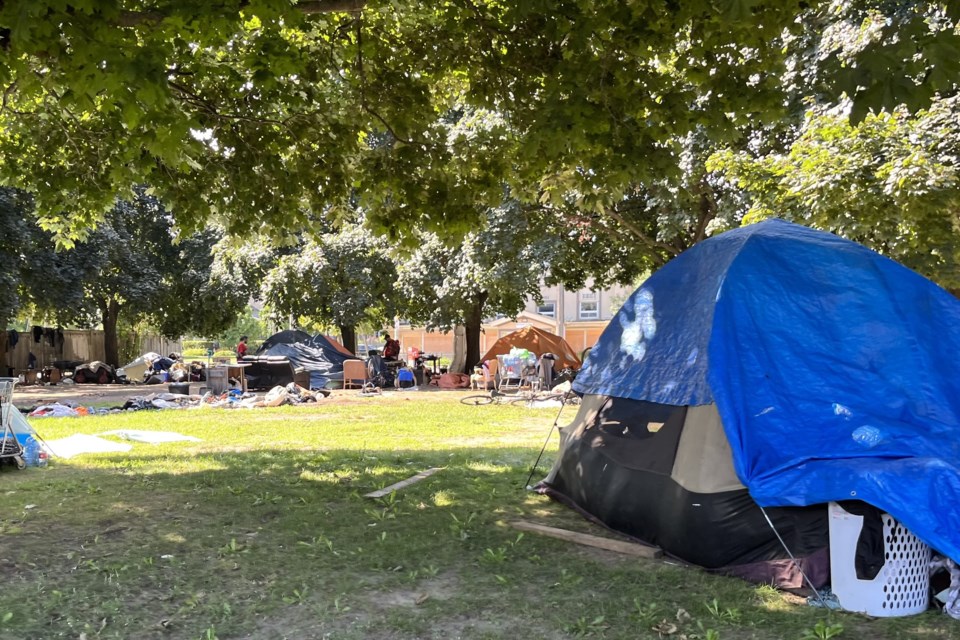The City of Hamilton is joining other municipalities to call for renewed partnerships and support from other levels of government to address the growing issue of homelessness in communities across Ontario.
In a press release issued Friday, the City states that it "continues to fund and monitor programs that together, work to support individuals and families in stabilizing housing and preventing or ending homelessness," but despite making progress "cannot do it alone."
“I will say this again…homelessness and affordable and supportive housing continue to be the most pressing issues the City of Hamilton and municipalities across Ontario, and all of Canada are facing; and addressing them requires real solutions,” said Mayor Andrea Horwath in the media release. which included some stark statistics:
- Hamilton currently has approximately 1,500-1,600 individuals experiencing homelessness, with an estimated 251 in encampments.
- There are approximately 747 shelter beds in Hamilton between permanent, temporary, and overflow shelter spaces.
- As approved through the City’s 2024 budget, $158 million was invested to increase affordable housing and reduce homelessness, an increase of 26 per cent ($33 million) over 2023.
- In 2024, City Council approved the expansion of Hamilton’s emergency shelter system by adding 272 new shelter spaces. As of Jan. 6, 2025, 129 shelter beds have been on-boarded through strategic partnerships with community providers. Of these new shelter spaces, 80 will be dedicated to the temporary low-barrier outdoor shelter site in the Barton/Tiffany area offering 24/7 mental health support, housing resources, and other essential services.
- In November 2024, the City of Hamilton joined communities across Canada in a coordinated effort to engage individuals experiencing homelessness and gather information about their housing history, health, and social needs. The findings from the Point in Time Count (PiTC) will be available in early 2025 and will inform local strategies to prevent and reduce homelessness, help the City better understand trends over time, and ensure resources are directed where they’re needed most.
“This crisis has been building for years," Horwath noted. "While we are increasing our investments in housing and homelessness initiatives, the message to our provincial and federal partners remains clear: Hamilton is doing everything that we can but the magnitude of the crises we face continues to grow. The fact is, while there has been some funding from both senior levels of government which we acknowledge and appreciate, it is nowhere near the scale of investment that is required. A significant ramping up of financial assistance from our partners is beyond urgent.”
The Association of Municipalities of Ontario (AMO), which represents Ontario’s 444 municipal governments, released new research in its report, Municipalities Under Pressure: The Growing Human and Financial Cost of Ontario’s Homelessness Crisis. According to the city's press release, the report documents the massive growth in homelessness in recent years and outlines how together, governments can reverse these trends.
Highlights from the AMO report include:
- In 2024, more than 80,000 people in Ontario experienced homelessness – up more than 25 per cent since 2022.
- The number of people experiencing prolonged or repeated episodes of homelessness has tripled since 2016. Chronic homelessness now accounts for more than half of the homeless population.
- Ontario is the only province in Canada where funding for social housing has been downloaded to municipalities. Municipal spending on homelessness and housing programs has sky-rocketed since 2020, growing to more than $2.1 billion in 2024.
- On deeply affordable housing alone, municipalities have increased spending by nearly $900 million since 2016, while provincial spending during that time increased by $45 million.
- An investment of $11 billion over 10 years is needed to boost the supply of supportive, transitional and community housing and increase prevention programs could end chronic homelessness in Ontario.
- Further, an estimated $2 billion over eight years with most investments in the first three years would largely solve the challenge of homeless encampments.
"These numbers demonstrate the need for wrap-around services and supports that extend beyond housing – there are gaps in healthcare, mental-health services, justice systems, and more that need to be addressed," stated the city's press release.
Hamilton’s local data helped inform the report findings, which were developed by AMO in partnership with the Ontario Municipal Social Services Association (OMSSA) and the Northern Ontario Service Delivery Association (NOSDA), and research led by Helpseeker Technologies.
“The scope and scale of homelessness across Ontario’s municipalities is truly unprecedented. Without real and meaningful provincial action, the quality of life and economic prosperity of Ontario’s communities is at risk. This is a solvable problem, but we need to work together,” said Robin Jones, President, Association of Municipalities of Ontario.
The City points out that it will remain focused on compassionate approaches to homelessness and advocating for preventive solutions such as mental health supports and income and affordability measures, but adds that municipal property taxes were never meant to fund income distribution on such a scale.
"Hamilton is committed to preventing and ending homelessness, but the problem cannot be solved at the municipal level alone," states the City's press release.



crop.png;w=120;h=80;mode=crop)